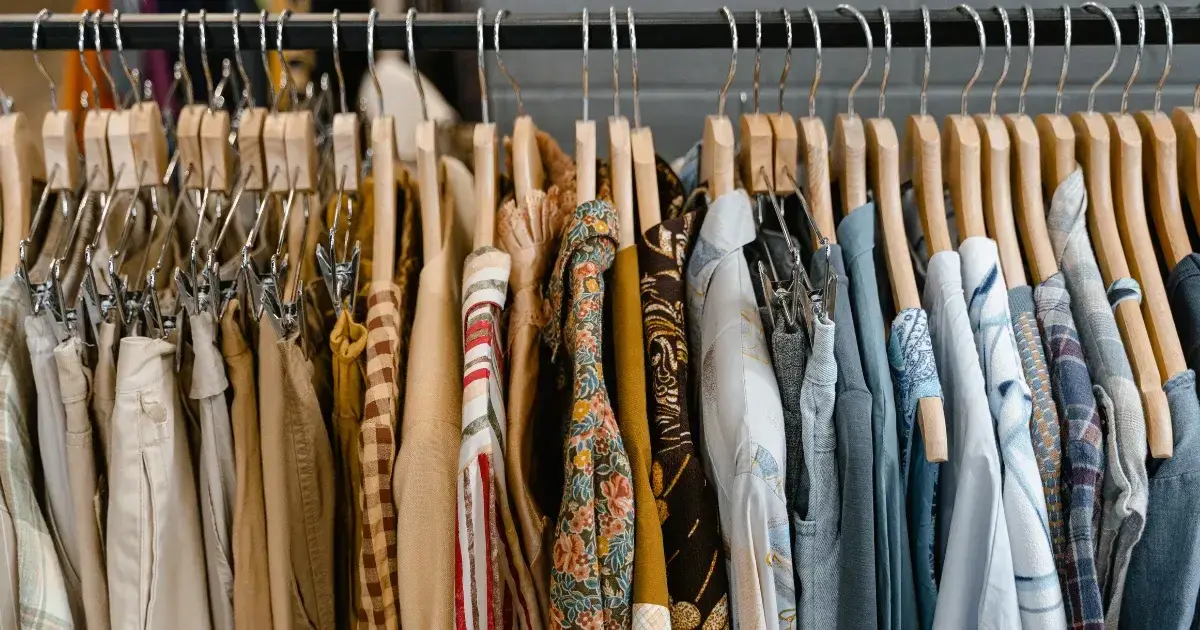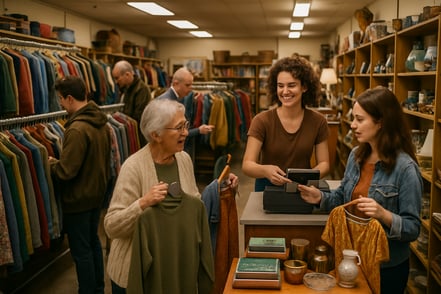
Your thrift store processes thousands of charitable donations daily. Are some valuable vintage pieces getting lost in the shuffle?
Even though vintage clothing pieces often end up donated following a move or an estate sale, most thrift stores lack the expertise to identify these gems.
Imagine your volunteer just priced a 1960s Halston dress for $8. It sold in 20 minutes to someone who immediately listed it online for $400. Ouch.
How can you get better at evaluating vintage clothing value in your store?
This guide equips your staff with the practical skills to accurately spot, evaluate, and price vintage clothing.
Evaluating Vintage Clothing Value in Today's Market
Let’s start with the basics before we dive into our step-by-step guide: what is vintage clothing?
Vintage clothing refers to authentic pieces that are at least 20 years old, typically from the 1920s through the early 2000s. Don't confuse this with "retro" items (new pieces made to look old) or "antique" clothing (over 100 years old).
Related Read: How To Increase Foot Traffic in Retail: 13 Tips for Thrift Stores
Vintage clothing is one of the hottest trends to hit the market in the past few years. Why? There are three major trends driving this boost in demand:
- Sustainability-focused customers choose vintage to combat fast fashion waste.
- Style-conscious shoppers want unique pieces you can't find at every mall store.
- Quality seekers are looking for construction techniques and craftsmanship that don’t exist in today’s throwaway fashion environment.
As a thrift store, you’re perfectly positioned to capitalize on this. Vintage pieces can command anywhere from $20-$1,000+ per piece. The challenge is recognizing the treasures that come in with the rest of your daily donations.
With this context in mind, let’s explore our ten-step process for finding the gems in your collection.
Step 1: Examine Labels and Tags
Step one is to ensure you and your volunteers examine the tags on every item that comes into your thrift store’s donation box. The label will tell you everything you need to know about a vintage clothing item if you know how to read it.
Pre-1980s labels have distinct characteristics that scream "valuable vintage." Look for pinked or zigzag edges where the label attaches to the garment, and labels that are actually sewn in rather than heat-transferred.
Union labels, especially those featuring the International Ladies' Garment Workers' Union (ILGWU), are one of the big “tells” of a valuable piece, as they indicate American-made pieces from before manufacturing moved overseas.
It’s important to note that designer labels have changed over the years, so do your research. The Chanel logo from the 1960s looks radically different from today’s version, for example.
When you find unfamiliar labels, photograph them clearly and use Google Lens or vintage fashion databases. Build a photo library of valuable labels you've discovered so you and your staff can reference the information later.
Related Read: Market Your Thrift Store on Zero Budget: Tips and Free Tools
Step 2: Assess Fabric Quality and Construction
The next method you can use to evaluate vintage clothing value is to take a look at the fabric quality and the construction of the piece.
Natural fibers — silk, wool, cotton, linen — age beautifully and feel substantial. Synthetic blends scream modern manufacturing and typically aren't worth premium pricing.
Look for hand-stitched details like French seams, bound buttonholes, and hand-sewn hems. These construction techniques cost too much for modern mass production and usually signify a more valuable vintage piece.
Related Read: Consignment Shops vs. Thrift Stores: Which Store Wins?
If you’re not sure how to date a piece you find, you’ll want to take a look at the fasteners. Metal zippers dominated until the 1960s, while plastic ones became standard afterward. Covered buttons, genuine mother-of-pearl, or early plastic bakelite buttons are more likely to be older and more valuable than modern plastic buttons.
Step 3: Research Era-Specific Design Elements
Every decade has its fashion trends, and these trends make dating and evaluating vintage clothing more straightforward once you know what you’re looking for. Let’s take a look at some of the biggest trends of some common vintage clothing eras:
- 1920s: Dropped waistlines, straight silhouettes, and elaborate beadwork on flapper dresses.
- 1940s: Structured shoulders and tight waists.
- 1950s: Full circle skirts and fitted bodices.
- 1960s: A-line shapes, mod patterns, and materials like vinyl and metallics.
- 1970s: Bohemian flowing fabrics, peasant styles, and earth tones.
- 1980s: Exaggerated shoulder pads, geometric patterns, and synthetic materials.
Train your eye to find items with these characteristics by studying fashion history resources and building a mental catalog of decade-specific details.
When you can quickly identify "that's definitely 1960s" versus "classic 1980s power dressing," you're well on your way to spotting valuable pieces and managing your cash flow accordingly.
Step 4: Identify Valuable Designer Brands
Not all designer labels are created equal, but knowing the heavy hitters can turn a $5 donation into a $500 sale.
Top-tier names like Chanel, Dior, Balenciaga, Yves Saint Laurent, and Halston command premium prices regardless of era. Mid-tier collectible brands vary by decade. You’ll want to familiarize yourself with items like the classic Diane von Furstenberg wrap dresses from the 1970s or 1980s Thierry Mugler power suits.
Related Read: 6 Creative Merchandising Strategies for Thrift Stores
Regional designers and boutique labels are another thing to keep an eye on. Do some research about the history of fashion in your community. A 1960s dress from a respected local couturier might outprice a mass-market designer piece.
Step 5: Evaluate Condition
Condition makes or breaks vintage value, but that doesn’t mean you should automatically dismiss pieces with a few flaws. Some light wear and tear can actually make a vintage item feel more authentic.
However, major damage like large tears, permanent stains, or structural issues can cut into your price point and valuation.
Common vintage problems include:
- Moth holes in wool
- Underarm staining
- Brittle fabric from age
Create condition categories: excellent (minor wear), good (noticeable but acceptable wear), fair (significant issues but still sellable), and poor (parts or craft use only), then price the pieces accordingly.
Step 6: Research Historical and Cultural Significance
Sometimes a piece's story matters more than its label. Items connected to historical events, cultural movements, or significant moments in fashion history command premium prices.
Look for pieces tied to movies, TV shows, or cultural icons. That 1980s blazer might be peak "working girl" fashion, while a 1990s slip dress channels minimalism's moment.
Subcultural significance adds value, too. Authentic punk pieces from the late 1970s, original hippie garments from the 1960s, or genuine mod clothing all have dedicated collector bases and might fetch a nice price from the right buyer, earning a loyal customer who comes back looking for more pieces.
Step 7: Check Current Market Prices and Trends
Smart pricing requires more than just identifying the piece for what it is — you need to understand the current market conditions.
Start with eBay's "sold listings.” This page will show what people actually paid for similar pieces that recently sold, not just asking prices. Search for your specific item or similar pieces, noting condition, size, and final sale prices.
Check multiple platforms, including vintage-specific marketplaces like Etsy, Vestiaire Collective, or TheRealReal. Also, be sure to stay current with fashion revival trends through vintage fashion blogs, social media, and industry publications. What's trending today directly impacts vintage values tomorrow.
Related Read: Bookkeeping for Thrift Stores: 7 Mistakes To Avoid
Step 8: Look for Unique Details and Embellishments
Details are one of the things that make vintage pieces so special. Certain embellishments will boost the value of a piece by a significant amount.
Hand-embroidered details, intricate beadwork, and genuine lacework represent the kind of craftsmanship many vintage clothing fans are looking for in pieces, which is why they shop vintage instead of simply buying new.
Original designer hardware matters too, especially in the case of designer pieces. Authentic Chanel buttons, YSL buckles, or designer zippers will always be worth more than a piece that looks great but has those elements replaced with generic versions.
You’ll also want to keep an eye out for complete sets. If you have a 1960s belt with all the related accessories, you can sell the full set together for more than you’d get for the sum of all the pieces separately.
Step 9: Consider Size and Fit Factors
Size is another crucial factor to consider when evaluating the value of vintage clothing.
Larger sizes in vintage clothing are rare. Clothing sizes tended to be smaller in decades past, and plus-size options were limited. If you find size 14+ vintage pieces, you’re looking at a seriously rare piece that will have strong demand from collectors.
Petite sizes and very tall cuts can also carry premiums depending on the item. It’s important to note that the rarity might make these items more valuable, but it also makes it more challenging to find a strong-fit buyer for them. The most common vintage sizes (equivalent to modern 6-10) have the broadest appeal.
Modern fit preferences also matter. 1980s oversized blazers work perfectly with current trends, while fitted 1950s styles might be less popular with current trend-chasers. Price accordingly and clearly state measurements, as vintage sizing differs dramatically from modern standards if you’re looking at a classic “S, M, L” sizing structure.
Step 10: Document and Price Your Finds
Finally, be sure to photograph all your vintage pieces. These pieces often sell online or attract in-store shoppers from online collectors, so be sure to take high-quality photos in good lighting that show the front, back, and detail shots of the label and any other special features.
Next, set your price! We recommend starting the pricing on a vintage piece slightly high, giving you room to negotiate or price-drop later if needed.
Related Read: Managing Retail Operating Costs in Your Thrift Store: 6 Tips
If your store ends up with several vintage pieces, you may want to adjust your store layout to create a dedicated rack or section in your store. Vintage item collectors will notice and may become repeat buyers when you carve out a section of your store specifically for them.
Finally, remember to optimize your vintage clothing valuation over time. Track which pieces sell quickly versus those that sit, and adjust your evaluation criteria based on actual sales data.
Evaluating Vintage Clothing Value and Running a Profitable Thrift Store
Implementing these ten steps can help you identify the valuable vintage pieces hiding in your store’s donation boxes.
If you become skilled at evaluating vintage clothing value, you might seek out additional donations and work on turning your store into the destination for vintage collectors in your area.
The payoff is substantial. Stores implementing proper vintage evaluation see dramatic increases in average sale prices and customer loyalty. You'll attract serious collectors who become repeat customers and spread the word about the killer finds in your store.
But if you want to get the most from your vintage clothing sales and pricing strategy, you need the right tools. The most important tool in your arsenal is a modern point of sale solution.
ThriftCart's specialized point of sale (POS) system includes features designed specifically for vintage inventory management, pricing flexibility, and detailed reporting that helps you track your most valuable finds.
Ready to simplify your vintage item valuation processes? Use our Build and price tool to find your ideal thrift store solution today.

 by
by 






